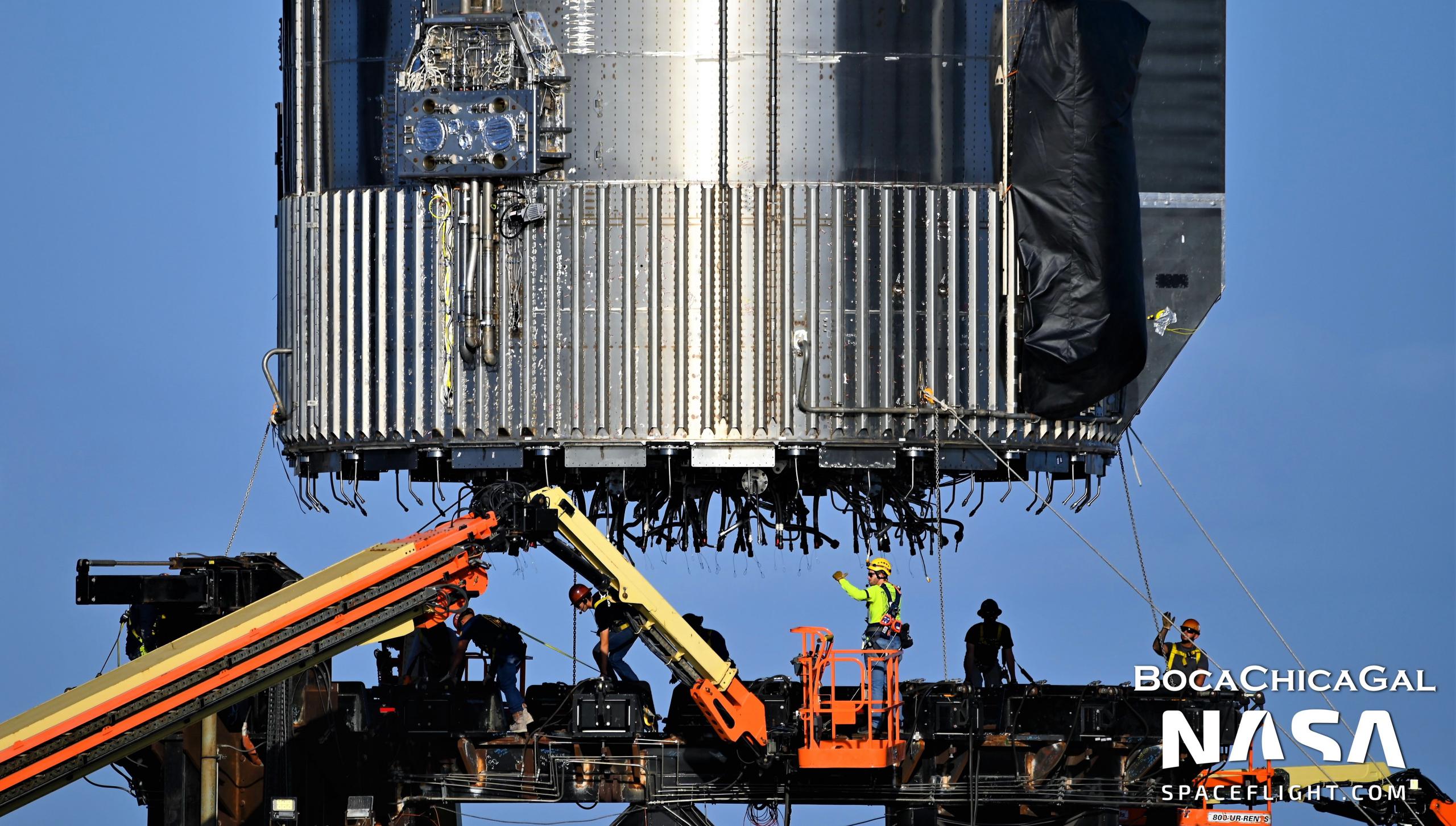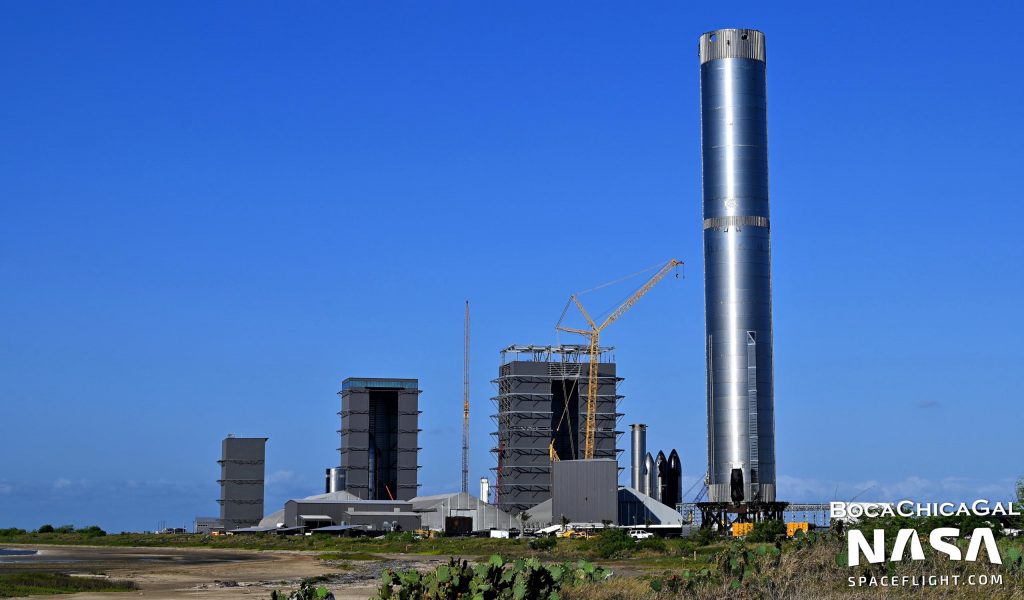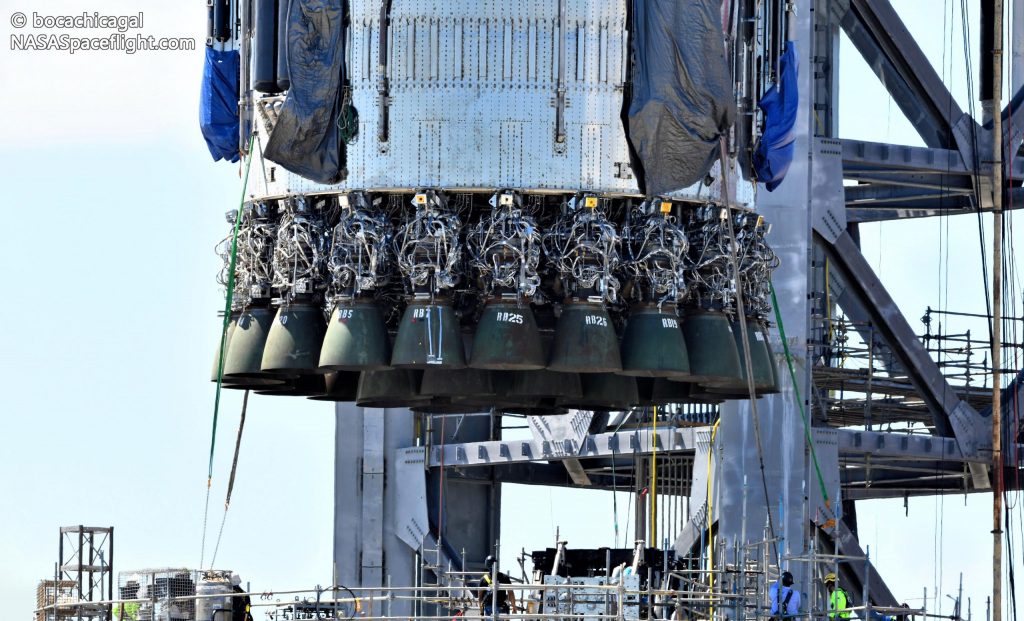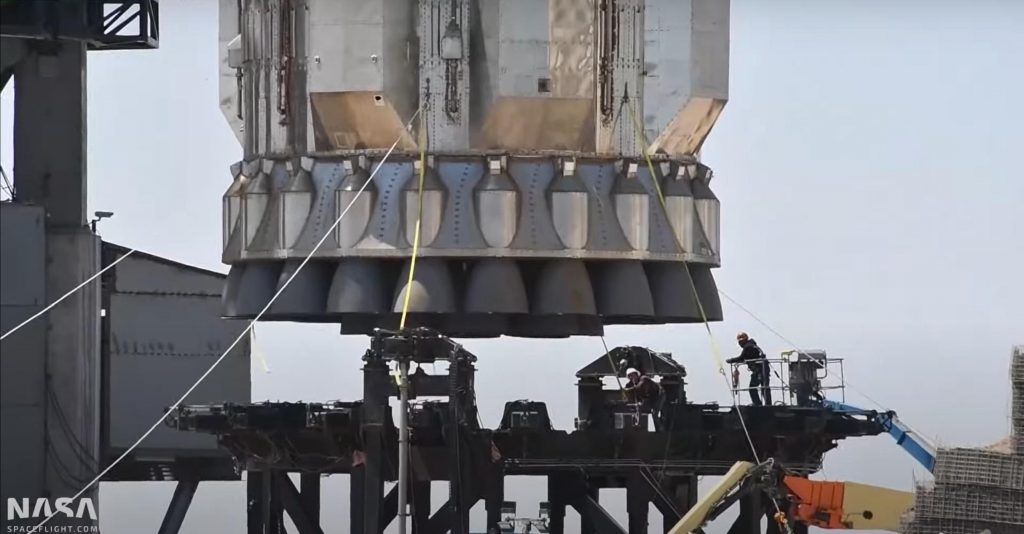

News
SpaceX begins installing new ‘Raptor 2’ engines on Super Heavy booster
SpaceX has begun installing new ‘Raptor 2’ engines on Super Heavy Booster 7 after the prototype completed a range of tests and returned to the company’s South Texas ‘Starbase’ rocket factory.
Earlier this month, SpaceX transported Booster 7 (B7) in the opposite direction, returning the 67-meter (~220 ft) tall rocket to Starbase’s orbital launch site (OLS) for the second time after it was forced to head back to the factory for repairs. Repairs completed, SpaceX dove headfirst into the process of verifying that the booster had been returned to full health and immediately filled its tanks to the brim with at least 3000 tons (>6.5M lb) of liquid nitrogen and oxygen – better known as a cryogenic proof test.
Less than 48 hours after completing its first post-repair test, Booster 7 sailed through another full cryoproof test without losing a beat. On May 13th, two days later, SpaceX attached a crane to Super Heavy B7 and removed it from the orbital launch mount before rolling the rocket back to Starbase’s build site on May 14th. Without official confirmation, which is increasingly rare, it was impossible to determine the results of the testing with certainty, but the speed of the process and Booster 7’s rapid launch mount removal made the two most extreme outcomes the most likely.
A quick return to the build site could have been explained by a significant vehicle failure or a major issue with SpaceX’s repair job – no point in continuing to test a vehicle that can’t be fully tested. On the exact opposite hand, a near-perfect test campaign in which all objectives were more or less achieved without major hiccups could also explain the quick return. In general, the evidence was in favor of the more optimistic explanation. Had a major issue been uncovered during the first post-repair cryoproof, it’s difficult to imagine that SpaceX would have completed the exact same test – in full less than 48 hours later.
However, SpaceX moved an in-situ Raptor engine installation stand towards Booster 7 and the orbital launch mount shortly before testing restarted, hinting – for the moment – that the company wanted to begin installing Raptor engines immediately after cryoproof testing. But mid-way through testing, the stand was moved back to its storage area and Super Heavy was instead removed from the mount and returned to the factory, adding a little uncertainty.

Concerns were immediately assuaged on May 17th when SpaceX was spotted moving Raptor engines from a production tent to the ‘megabay’ assembly building containing Booster 7. While the location of the new bay makes it difficult to peek inside from public viewpoints, preventing direct confirmation, it’s very likely SpaceX has begun installing new Raptor 2 engines on Super Heavy B7.
Additionally, confirming some of the more optimistic speculation about SpaceX’s decision to move Booster 7 back to build site, two of the three Raptor engines spotted on May 17th were also labeled “E26” and “E28.” Unless SpaceX’s engine numbering conventions have changed, the labels identify the engines as three of 20 ‘Raptor Boost’ engines that will ultimately populate the outer ring of Super Heavy B7’s aft end. More importantly, the installation of any Raptor Boost 2 (RB2) engines likely indicates that SpaceX has decided to install a full set of 33 Raptors on the booster before kicking off static fire testing.


To limit risk, SpaceX could have begun test-firing Booster 7 with just 1-3 Raptor engines installed and gradually added more as confidence grew. Instead, SpaceX appears to have accepted the added risk of losing 33 brand-new Raptor 2 engines in one fell swoop in return for the possibility of a much faster test campaign. If there are no major surprises during static fire testing, in other words, Booster 7 could be ready for flight far more quickly if the process begins with all 33 engines already installed. Installing Booster 7’s Raptors, heat shield, and aerocovers will be easier back at the build site.
Doing it all at once should also help prevent Booster 7 from suffering Booster 4’s fate and wallowing, unfinished, for months without completing a single useful test. If the gamble works, the first stage of a two-stage Starship could be ready for an orbital launch attempt in just a few months. If the gamble fails and Booster 7 is damaged, destroyed, or otherwise unable to pass the necessary tests, SpaceX will simply move on to Booster 8 sooner than later, having wasted less time on a more cautious Booster 7 test campaign.
It’s unclear how long it will take SpaceX to install all 33 Raptors, construct a heat shield around those engines, and finish buttoning up the rest of Booster 7. In an adjacent assembly bay, SpaceX appears to have nearly finished assembling a similarly upgraded Starship – Ship 24 – that’s first in line to ride Booster 7 into space. The company has also tentatively requested road closures for three 12-hour test windows on May 23rd, 24th, and 25th that either vehicle could use.
News
Tesla UK sales see 14% year-over-year rebound in June: SMMT data
The SMMT stated that Tesla sales grew 14% year-over-year to 7,719 units in June 2025.

Tesla’s sales in the United Kingdom rose in June, climbing 14% year-over-year to 7,719 units, as per data from the Society of Motor Manufacturers and Traders (SMMT). The spike in the company’s sales coincided with the first deliveries of the updated Model Y last month.
Model Y deliveries support Tesla’s UK recovery
Tesla’s June performance marked one of its strongest months in the UK so far this year, with new Model Y deliveries contributing significantly to the company’s momentum.
While the SMMT listed Tesla with 7,719 deliveries in June, independent data from New AutoMotive suggested that the electric vehicle maker registered 7,891 units during the month instead. However, year-to-date figures for Tesla remain 2% down compared to 2024, as per a report from Reuters.
While Tesla made a strong showing in June, rivals are also growing. Chinese automaker BYD saw UK sales rise nearly fourfold to 2,498 units, while Ford posted the highest EV growth among major automakers, with a more than fourfold increase in the first half of 2025.
Overall, the UK’s battery electric vehicle (BEV) demand surged 39% to to 47,354 units last month, helping push total new car sales in the UK to 191,316 units, up 6.7% from the same period in 2024.
EV adoption accelerates, but concerns linger
June marked the best month for UK car sales since 2019, though the SMMT cautioned that growth in the electric vehicle sector remains heavily dependent on discounting and support programs. Still, one in four new vehicle buyers in June chose a battery electric vehicle.
SMMT Chief Executive Mike Hawes noted that despite strong BEV demand, sales levels are still below regulatory targets. “Further growth in sales, and the sector will rely on increased and improved charging facilities to boost mainstream electric vehicle adoption,” Hawes stated.
Also taking effect this week was a new US-UK trade deal, which lowers tariffs on UK car exports to the United States from 27.5% to 10%. The agreement could benefit UK-based EV producers aiming to expand across the country.
News
Tesla Model 3 ranks as the safest new car in Europe for 2025, per Euro NCAP tests
Despite being on the market longer than many of its rivals, the Tesla Model 3 continues to set the bar for vehicle safety.

The Tesla Model 3 has been named the safest new car on sale in 2025, according to the latest results from the Euro NCAP. Among 20 newly tested vehicles, the Model 3 emerged at the top of the list, scoring an impressive 359 out of 400 possible points across all major safety categories.
Tesla Model 3’s safety systems
Despite being on the market longer than many of its rivals, the Tesla Model 3 continues to set the bar for vehicle safety. Under Euro NCAP’s stricter 2025 testing protocols, the electric sedan earned 90% for adult occupant protection, 93% for child occupant protection, 89% for pedestrian protection, and 87% for its Safety Assist systems.
The updated Model 3 received particular praise for its advanced driver assistance features, including Tesla’s autonomous emergency braking (AEB) system, which performed well across various test scenarios. Its Intelligent Speed Assistance and child presence detection system were cited as noteworthy features as well, as per a WhatCar report.
Other notable safety features include the Model 3’s pedestrian-friendly pop-up hood and robust crash protection for both front and side collisions. Euro NCAP also highlighted the Model 3’s ability to detect vulnerable road users during complex maneuvers, such as turning across oncoming traffic.
Euro NCAP’s Autopilot caution
While the Model 3’s safety scores were impressive across the board, Euro NCAP did raise concerns about driver expectations of Tesla’s Autopilot system. The organization warned that some owners may overestimate the system’s capabilities, potentially leading to misuse or inattention behind the wheel. Even so, the Model 3 remained the highest-scoring vehicle tested under Euro NCAP’s updated criteria this year.
The Euro NCAP’s concerns are also quite interesting because Tesla’s Full Self-Driving (FSD) Supervised, which is arguably the company’s most robust safety suite, is not allowed for public rollout in Europe yet. FSD Supervised would allow the Model 3 to navigate inner city streets with only minimal human supervision.
Other top scorers included the Volkswagen ID.7, Polestar 3, and Geely EX5, but none matched the Model 3’s total score or consistency across categories. A total of 14 out of 20 newly tested cars earned five stars, while several models, including the Kia EV3, MG ZS, and Renault 5, fell short of the top rating.
Elon Musk
Why Tesla’s Q3 could be one of its biggest quarters in history
Tesla could stand to benefit from the removal of the $7,500 EV tax credit at the end of Q3.

Tesla has gotten off to a slow start in 2025, as the first half of the year has not been one to remember from a delivery perspective.
However, Q3 could end up being one of the best the company has had in history, with the United States potentially being a major contributor to what might reverse a slow start to the year.
Earlier today, the United States’ House of Representatives officially passed President Trump’s “Big Beautiful Bill,” after it made its way through the Senate earlier this week. The bill will head to President Trump, as he looks to sign it before his July 4 deadline.
The Bill will effectively bring closure to the $7,500 EV tax credit, which will end on September 30, 2025. This means, over the next three months in the United States, those who are looking to buy an EV will have their last chance to take advantage of the credit. EVs will then be, for most people, $7,500 more expensive, in essence.
The tax credit is available to any single filer who makes under $150,000 per year, $225,000 a year to a head of household, and $300,000 to couples filing jointly.
Ending the tax credit was expected with the Trump administration, as his policies have leaned significantly toward reliance on fossil fuels, ending what he calls an “EV mandate.” He has used this phrase several times in disagreements with Tesla CEO Elon Musk.
Nevertheless, those who have been on the fence about buying a Tesla, or any EV, for that matter, will have some decisions to make in the next three months. While all companies will stand to benefit from this time crunch, Tesla could be the true winner because of its sheer volume.
If things are done correctly, meaning if Tesla can also offer incentives like 0% APR, special pricing on leasing or financing, or other advantages (like free Red, White, and Blue for a short period of time in celebration of Independence Day), it could see some real volume in sales this quarter.
You can now buy a Tesla in Red, White, and Blue for free until July 14 https://t.co/iAwhaRFOH0
— TESLARATI (@Teslarati) July 3, 2025
Tesla is just a shade under 721,000 deliveries for the year, so it’s on pace for roughly 1.4 million for 2025. This would be a decrease from the 1.8 million cars it delivered in each of the last two years. Traditionally, the second half of the year has produced Tesla’s strongest quarters. Its top three quarters in terms of deliveries are Q4 2024 with 495,570 vehicles, Q4 2023 with 484,507 vehicles, and Q3 2024 with 462,890 vehicles.
-

 Elon Musk4 days ago
Elon Musk4 days agoTesla investors will be shocked by Jim Cramer’s latest assessment
-

 News1 week ago
News1 week agoTesla Robotaxi’s biggest challenge seems to be this one thing
-

 Elon Musk2 weeks ago
Elon Musk2 weeks agoFirst Look at Tesla’s Robotaxi App: features, design, and more
-

 News2 weeks ago
News2 weeks agoSpaceX and Elon Musk share insights on Starship Ship 36’s RUD
-

 News2 weeks ago
News2 weeks agoWatch Tesla’s first driverless public Robotaxi rides in Texas
-

 News1 week ago
News1 week agoWatch the first true Tesla Robotaxi intervention by safety monitor
-

 News2 weeks ago
News2 weeks agoTesla has started rolling out initial round of Robotaxi invites
-

 Elon Musk2 weeks ago
Elon Musk2 weeks agoTesla to launch in India in July with vehicles already arriving: report


















